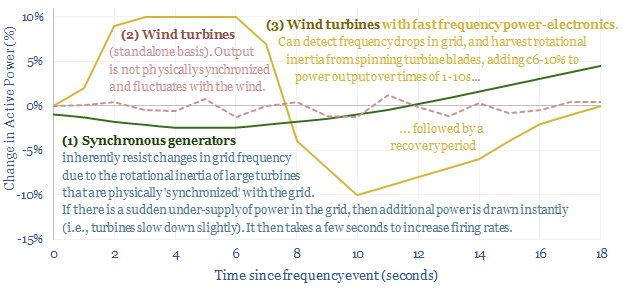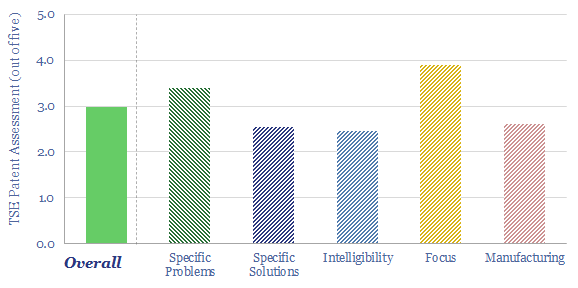Goldwind is one of the largest wind turbine manufacturers in the world, having delivered over 50,000 turbines by early-2023. The company was founded in 1998, headquartered in Beijing, it has 11,000 employees, and shares are publicly listed.
The wind industry is increasingly aiming to mimic the inertia and frequency response of synchronous power generators. Goldwind has published some interesting case studies, boosting power by 6-10%, within 1-2 seconds, for 5-6 seconds. Hence this data-file reviews Goldwind frequency response patents to look for an edge?
Synchronous power generators have ‘inertia’. If the grid suddenly becomes short of power, due to a large new load switching on, or a large power source disconnecting, then all of these synchronized machines will slow down very slightly, and in unison. Harvesting their rotational energy provides more power to the grid. But it also lowers the ‘frequency’ of the grid. At least for a few seconds, until firing rates can be ramped up. Generally, the larger the synchronous power generators, the higher their ‘inertia’, the more power that can be drawn out as they slow down, and the less grid frequency will drop per unit of incremental power. This is all crucial to the functioning of a modern power grid.
Wind turbines do not inherently provide any inertia or frequency response. Interestingly, they have about the same amount of angular momentum as conventional power generators, as they spin. But it is not synchronized with the grid. A wind turbine spins at 15-20 revolutions per minute, whereas a typical grid at 50 Hz (or 60 Hz in the US) is completing 50 full AC cycles per second.
An increasing goal for the wind industry is to ‘mimic’ some of the inertia and frequency responses of synchronous generators. Recently, Goldwind has published interesting case studies at wind farms, e.g., in Australia, boosting power by 6-10%, within 1-2 seconds, for 5-6 seconds (chart below).

The goal of this patent screen is to evaluate whether Goldwind’s frequency response algorithms give it an edge over other wind turbine manufacturers. We were unable to de-risk this idea from reviewing the patents, for the reasons explained in the data-file.
There are three key challenges for implementing frequency responses, as a form of ‘synthetic inertia’ and wind power plants, which are also borne out by the patent analysis. It takes time to implement the response (certainly longer than a battery, capacitor bank or conventional generator). Second, it is challenging to coordinate the responses of dozens of turbines, each with a different operating state. Third, there is always a danger that the wind drops at the precise moment you want to implement your frequency response, due to natural wind volatility.
Goldwind frequency response? Goldwind discusses possible solutions to each of these challenges in its patents. The bright spot is that we think many of the solutions are software-side, which will lower their implementation cost, and not pull too hard on already-bottlenecked power electronics. However, as usual, we find it harder to de-risk algorithm-heavy patents.

